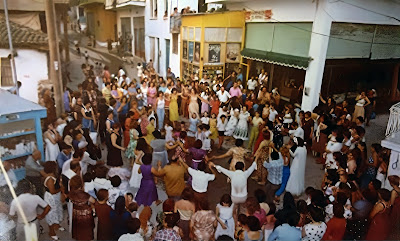Το κάστρο του Σιδηροκάστρου, η σχέση του με τον Βασιλιά Φίλιππο,σε βιβλίο του Abbott, 1903
Στο βιβλίο με τίτλο Macedonian folklore του Abbott, G. F. (George Frederick), που εκδόθηκε το 1903 ο συγγραφέας μας μιλάει για την σχέση του κάστρου του Σιδηροκάστρου με τον Βασιλιά Φίλιππο τον Β΄ πατέρα του Μεγάλου Αλεξάνδρου.
Ο Abbott αναφέρει αυτό που πίστευαν οι κάτοικοι της περιοχής στις αρχές του 20ου αιώνα, πράγμα που είναι αποδεκτό (ως προς το τι πίστευαν) μιας και έχουμε βρει και αναρτήσει αρκετές πληροφορίες από πολλές πηγές.
Υπάρχουν αναφορές και ποιήματα της εποχής που μιλάνε για την σύνδεση του κάστρου με τον Βασιλιά Φίλιππο τις οποίες σας έχουμε παρουσιάσει, όπως π.χ. «Οι πλύστραις για τοις βασιλοπούλαις» του Ν.Γ. Πολίτη, 1904
Αυτό που συναντάμε για πρώτη φορά είναι η αναφορά στο "Πέτρινο βάζο για χρήματα" με την επιγραφή Βασιλιάς Φίλιππος,
Αυτό μάλλον ήταν η αιτία να πυροδοτήσει την άποψη ΄πως το κάστρο κατασκευάστικε στα χρόνια του Βασιλιά Φίλιππου.
Μαζί με το βάζο ο Abbott αναφέρει και άλλα ευρήματα που βρέθηκαν στο κάστρο του Σιδηροκάστρου πριν το 1903, τα οποία δεν γνωρίζουμε που έχουν καταλήξει.
CHAPTER ΧΥ.
ALEXANDER AND PHILIP IN FOLK-TRADITION.
EVERYTHING that savours of antiquity is by the Macedonian
peasant attributed to the two great kings of his country. His
songs and traditions, of which he is vastly and justly proud, are
often described as having come down “from the times of Philip
and Alexander—and Herakles,” a comprehensive period to
which all remnants of the past are allotted with undiscrimi-
nating impartiality.
On the way from Drama to Cavalla, and a little back from
the road, stand the massive relics of an ancient gate, facing the
ruins of Philippi. This pile is known to the people by the
name of “Alexander the Great’s Palace” (τὸ Παλάτι τοῦ
Μεγάλου ᾿Αλεξάνδρου).
At Demir Hissar, or “The Iron Castle,” on the Salonica-
Serres railway line, there are some remnants of an old citadel,
or fortress (κάστρο), overlooking the ravine between the flanks
of which the town is wedged. These ruins are assigned to
King Philip. A big stone jar discovered among them some
time ago was promptly labelled “ King Philip’s money-jar, or
treasury.” The same romantic tradition discerns in two smooth
stones, lying on the rocky bank of the local river, the “ Washing-
boards” on which “The Princesses” (Βασιλοπούλαις)--- 8
daughters of King Phbilip—used to bleach (λευκαίνουν) their
clothes in the manner of Macedonian women at the present day.
The two solitary rocks in the plain of Serres, already noted
as the “Dragon’s Quoits,’ are by the inhabitants of Nigrita
called the “Quoits of Alexander the Great” (Πέτραις τοῦ
Μεγάλου ᾿Αλεξάνδρου), who is supposed to have thrown them ;
for did he not live in the age when, according to a muleteer’s
phrase, “God was wont to vouchsafe heroic might to men”
(a&iwve τοὺς ἀντρειωμένους)

_0163.jpg)



